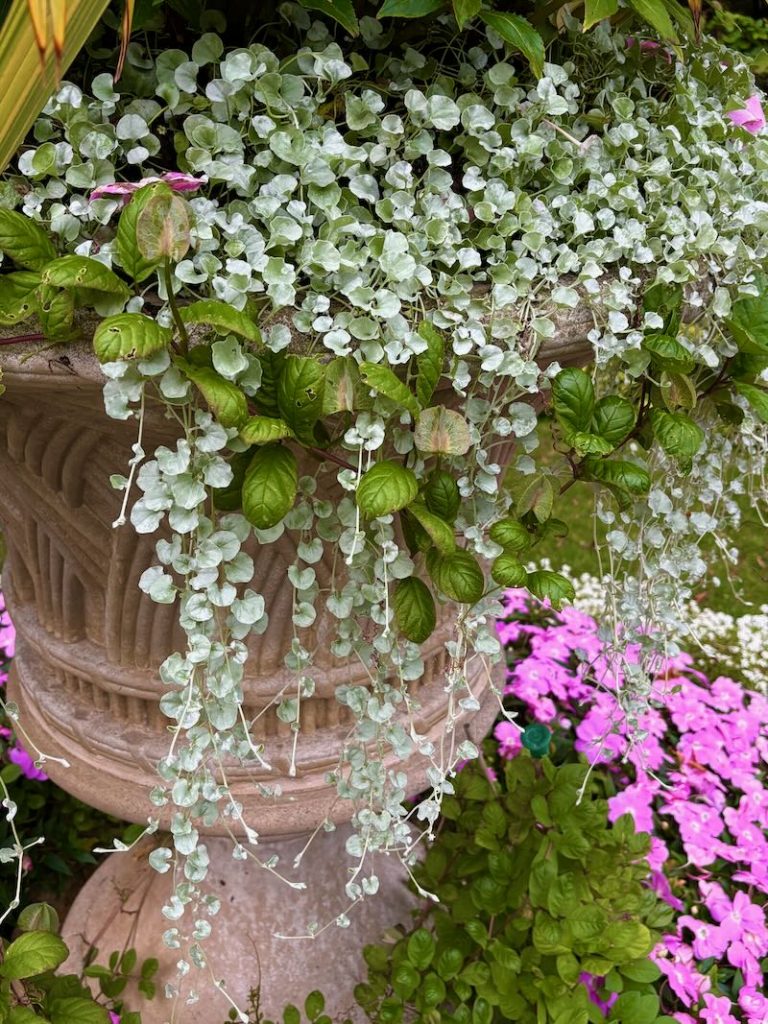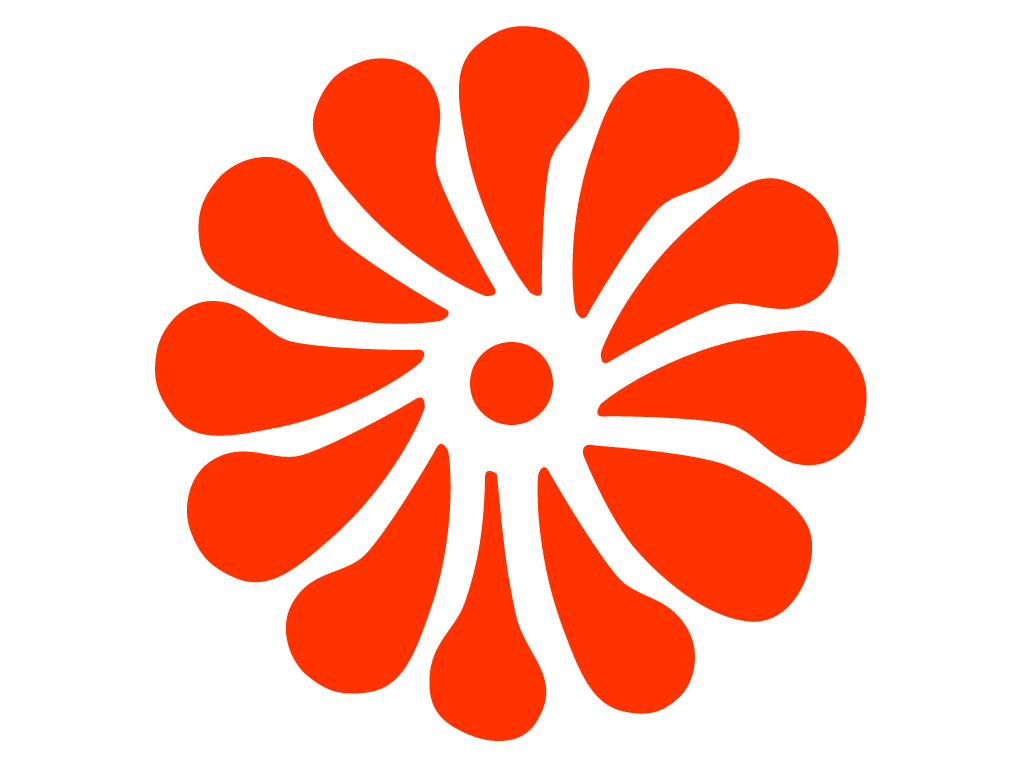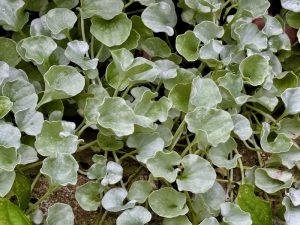Dichondra argentea : A Shimmering Groundcover for Bold Garden Texture
Dichondra argentea, commonly known as Silver Ponysfoot or Silver Ponyfoot, is a striking foliage plant beloved for its trailing, metallic-silver leaves and ground-hugging habit. Native to the arid regions of northern Mexico and the southwestern United States, this evergreen perennial is a favorite in drought-tolerant gardens, hanging baskets, and modern container designs. Belonging to the Convolvulaceae family—the same family as morning glories—Dichondra argentea brings a unique softness and light-reflective glow to outdoor spaces.
The Allure of Dichondra argentea
The first thing you notice about Dichondra argentea is its shimmering silver foliage. Each leaf is shaped like a tiny horse hoof—hence the name “ponyfoot”—and covered in fine, velvety hairs that reflect sunlight like metal. The effect is dazzling, especially in full sun where the silvery tones really pop.
Despite its delicate appearance, this plant is tough. It hugs the ground tightly, forming dense mats up to 75 cm (30 inches) across and reaching just about 10 cm (4 inches) tall. The low profile makes it ideal for edging pathways, spilling from raised beds, or cascading down walls and containers.
In warm climates, this plant grows as a true perennial. In colder zones, it’s often grown as an annual or overwintered indoors. It’s fast-growing, low-maintenance, and surprisingly resilient.
How to Grow Dichondra argentea
Light
Give Dichondra argentea full sun for the most vibrant silver color and dense growth. Aim for at least 6 hours of direct sunlight per day. It can handle partial shade, but the leaves may take on a duller green tone and the plant may grow less vigorously.
Soil
Soil quality is key. Dichondra argentea thrives in well-drained soils. Sandy loam or loamy soil is ideal. Avoid heavy clay soils or overly rich mixes high in organic matter, which retain too much moisture and increase the risk of root rot.
A standard commercial potting mix works well in containers, especially if amended with sand or perlite for added drainage.
Watering
This plant prefers drier conditions. Water moderately and allow the soil to dry out between waterings. It’s better to underwater than overwater. Once established, Dichondra argentea is quite drought-tolerant.
In containers, keep a closer eye on moisture. They dry out faster, especially in hot weather, but still don’t require frequent watering.
Temperature and Humidity
Dichondra argentea loves heat. It grows best in temperatures between 20°C and 24°C (68°F to 75°F). It’s not frost-hardy and should be protected or brought indoors when temperatures dip below 5°C (41°F).
Though it prefers dry air, it can tolerate some humidity if the soil remains well-drained.
Fertilizing
This plant has low nutrient needs. A single application of a balanced, slow-release fertilizer in early spring is enough to encourage full growth. Too much fertilizer can actually harm the plant by promoting excessive softness in stems or root problems.
Pruning and Maintenance
Regular trimming encourages a more compact, fuller look. If stems become leggy or tangled, just snip them back. Pinching the ends of stems helps promote branching. If you’re growing it in a container, you can shape it for a tidy trailing effect.
Propagation
Dichondra argentea is easily propagated from stem cuttings. Simply snip a healthy trailing section, remove the lower leaves, and press it into moist, well-draining soil. Keep it slightly humid until roots develop, which usually happens in 1–2 weeks.
It can also be grown from seed, though cuttings are much faster and more reliable for maintaining the same growth habit and color.
Pests and Diseases
This plant is relatively resistant to most pests and diseases. Aphids, spider mites, or whiteflies may occasionally appear, especially if the plant is stressed or indoors. A spray of water or insecticidal soap usually resolves the issue.
Overwatering is the most common problem. Root rot can develop if soil is too wet or poorly draining. Always err on the dry side when caring for Dichondra argentea.
Where to Use
Dichondra argentea is incredibly versatile. Here are some of its best uses in the landscape:
- Groundcover: Ideal for hot, dry slopes or areas where turf grass struggles. Its dense mat suppresses weeds and helps prevent soil erosion.
- Container Spiller: Perfect for hanging baskets, mixed planters, or pots. Its silver trails cascade beautifully over the sides.
- Edging Plant: Great along borders, walkways, or patios where it can spill naturally and soften hard edges.
- Rock Gardens: Its low, spreading habit and shimmering leaves make it a star among rocks and gravel.
- Green Roofs and Living Walls: Lightweight and drought-resistant, it thrives in shallow growing media and brings texture to vertical plantings.
Its striking foliage also pairs well with plants like purple verbena, blue lobelia, black mondo grass, or dark-leaved coleus, offering high-contrast color schemes.
Dichondra argentea in Xeriscaping
If you’re gardening with water conservation in mind, Dichondra argentea is a must-have. Once established, it handles drought with ease, reducing the need for irrigation. Its reflective leaves also reduce heat absorption, keeping the soil cooler and reducing water evaporation.
This makes it ideal for xeriscapes, rock gardens, or urban courtyards where water is scarce and sunlight is abundant.
Blooming Isn’t the Main Show
While Dichondra argentea does bloom—producing tiny white or pale green flowers from late spring into summer—the flowers are subtle and often overlooked. They blend into the foliage and don’t detract from the plant’s main appeal: its foliage. If you’re seeking floral drama, this plant isn’t it. But if you want elegance and texture, Silver Ponysfoot delivers.
Final Thoughts on Dichondra argentea
For gardeners looking to combine low maintenance with visual impact, Dichondra argentea is a standout choice. Its adaptability, silvery elegance, and ability to thrive in heat and drought make it a valuable addition to both traditional and contemporary gardens.
Whether tumbling from a container or carpeting a sun-drenched slope, this silver-leaved beauty adds movement, light, and texture like few others. Pair it thoughtfully, water it sparingly, and enjoy its quiet, silvery brilliance season after season.



